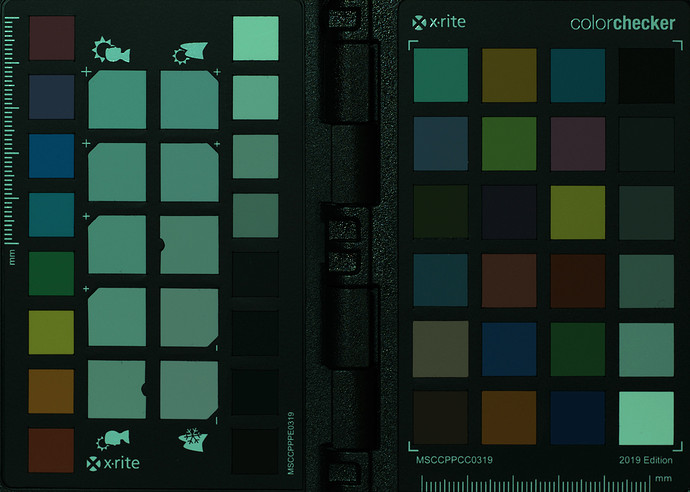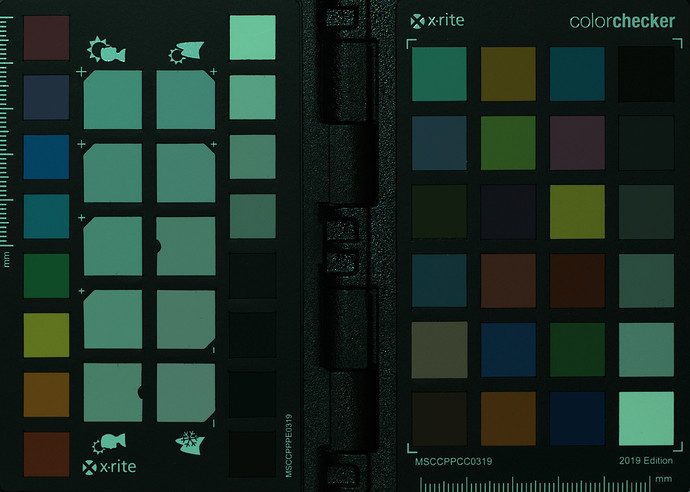Used the wrong cht file in my first attempt, results are slightly different:
Having a look at these with XnView, immediately after downloading: Roughly half of the patches of the manual tif are noticeably darker compared to the reference tif. Not sure if the other patches are influenced as well, but I’m guessing they are.
Running scanin on colorcheckr-sample-manual.tif:
$ /opt/Argyll_V2.1.2/bin/scanin -v -p -dipn colorcheckr-sample-manual.tif /opt/Argyll_V2.1.2/ref/ColorChecker.cht /home/jade/.local/git/dcamprof/data-examples/cc24_ref-new.cie
Input file 'colorcheckr-sample-manual.tif': w=1090, h=719, d = 3, bpp = 16
Data input file '/home/jade/.local/git/dcamprof/data-examples/cc24_ref-new.cie'
Data output file 'colorcheckr-sample-manual.ti3'
Chart reference file '/opt/Argyll_V2.1.2/ref/ColorChecker.cht'
Creating diagnostic tiff file 'diag.tif'
About to allocate scanrd_ object
Verbosity = 2, flags = 0x62a01
About to read input tiff file and discover groups
adivval = 1.000000
About to calculate edge lines
94 useful edges out of 107
About to calculate perspective correction
Perspective correction factors = -0.000010 0.000000 545.000000 359.500000
About to calculate rotation
Mean angle = 0.108095
Standard deviation = 0.653510
Robust mean angle = 0.091734 from 81 lines
About to calculate feature information
About to read reference feature information
Read of chart reference file succeeded
About to match features
Checking xx
Checking yy
Checking xy
Checking yx
Checking xix
Checking yiy
Checking xiy
Checking yix
Axis matches for each possible orientation:
0: xx = 0.168754, yy = 0.177742, xx.sc = 0.293563, yy.sc = 0.293267
90: xiy = 0.084548, yx = 0.191020, xiy.sc = 0.573383, yx.sc = 0.372608
180: xix = 0.168315, yiy = 0.132635, xix.sc = 0.293563, yiy.sc = 0.293267
270: xy = 0.084583, yix = 0.187454, xy.sc = 0.573383, yix.sc = 0.234639
r0 = 0.244845, r90 = 0.135748, r180 = 0.214079, r270 = 0.084157
There are 0 candidate rotations:
About to write diag file
/opt/Argyll_V2.1.2/bin/scanin: Error - Scanin failed with code 0x3, Pattern match wasn't good enough
Error occured and I cannot continue. The diag.tif
Running scanin on colorcheckr-sample-reference.tif:
$ /opt/Argyll_V2.1.2/bin/scanin -v -p -dipn colorcheckr-sample-reference.tif /opt/Argyll_V2.1.2/ref/ColorChecker.cht /home/jade/.local/git/dcamprof/data-examples/cc24_ref-new.cie
Input file 'colorcheckr-sample-reference.tif': w=1090, h=719, d = 3, bpp = 16
Data input file '/home/jade/.local/git/dcamprof/data-examples/cc24_ref-new.cie'
Data output file 'colorcheckr-sample-reference.ti3'
Chart reference file '/opt/Argyll_V2.1.2/ref/ColorChecker.cht'
Creating diagnostic tiff file 'diag.tif'
About to allocate scanrd_ object
Verbosity = 2, flags = 0x62a01
About to read input tiff file and discover groups
adivval = 1.000000
About to calculate edge lines
153 useful edges out of 199
About to calculate perspective correction
Perspective correction factors = -0.000002 -0.000001 545.000000 359.500000
About to calculate rotation
Mean angle = 0.104256
Standard deviation = 0.610275
Robust mean angle = 0.088960 from 124 lines
About to calculate feature information
About to read reference feature information
Read of chart reference file succeeded
About to match features
Checking xx
Checking yy
Checking xy
Checking yx
Checking xix
Checking yiy
Checking xiy
Checking yix
Axis matches for each possible orientation:
0: xx = 0.308687, yy = 0.358595, xx.sc = 0.287892, yy.sc = 0.291609
90: xiy = 0.156132, yx = 0.264904, xiy.sc = 0.570563, yx.sc = 0.372744
180: xix = 0.337920, yiy = 0.337946, xix.sc = 0.287630, yiy.sc = 0.291609
270: xy = 0.157982, yix = 0.292337, xy.sc = 0.570563, yix.sc = 0.372705
r0 = 0.467127, r90 = 0.200882, r180 = 0.471389, r270 = 0.217062
There are 2 candidate rotations:
cc = 0.467127, irot = 0.088960, xoff = -43.273007, yoff = -19.679275, xscale = 3.473525, yscale = 3.429254
cc = 0.471389, irot = 180.088960, xoff = -1111.115879, yoff = -757.046693, xscale = 3.476690, yscale = 3.429254
About to compute match transform for rotation 0.088960 deg.
About to setup value scanrdg boxes
About to read raster values
About to compute expected value correlation
About to compute match transform for rotation 180.088960 deg.
About to setup value scanrdg boxes
About to read raster values
About to compute expected value correlation
Expected value distance values are:
0, rot 0.088960: 2728.691291
1, rot 180.088960: 3972.455379
Chosen rotation 0.088960 deg. as best
About to compute final match transform
Improve match
About to setup value scanrdg boxes
About to read raster values
About to write diag file
Writing output values to file 'colorcheckr-sample-reference.ti3'
The diag.tif
Not sure if still relevant but: No errors in the following 2 steps, here are the files created (tie, json and dcp):
colorcheckr-sample-reference.zip (802.1 KB)





